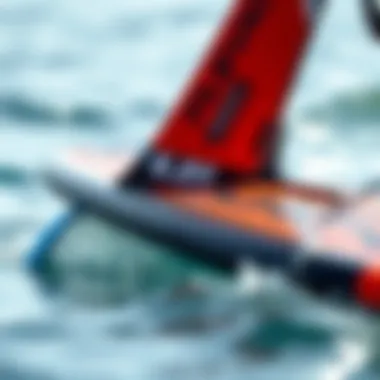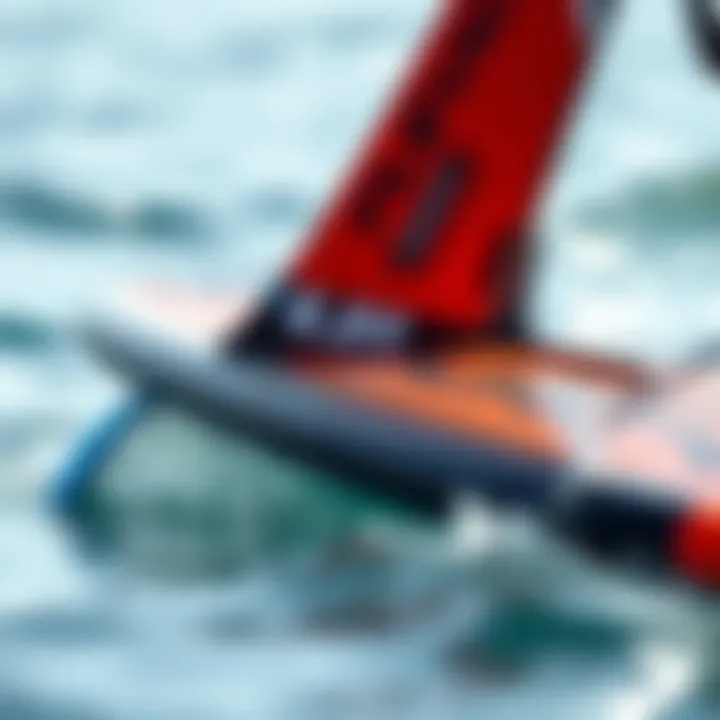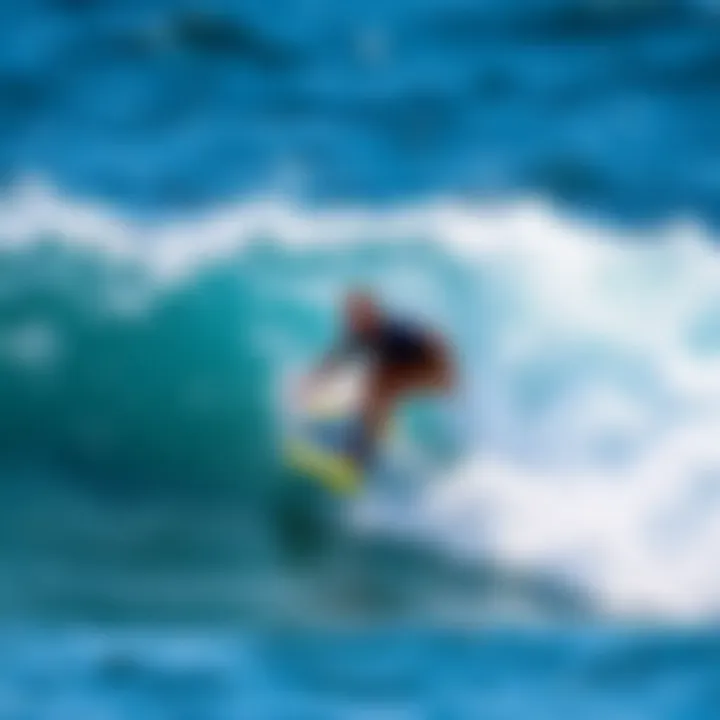Foil Surfboards: Understanding the Craft of Riding Waves


Expert Insights
In the ever-evolving world of watersports, foil surfing has taken a front-row seat as a burgeoning discipline that more athletes are eager to explore. With advancements in material engineering and hydrodynamic performances, the design of foil surfboards has strayed far beyond traditional surfing models. Today, enthusiasts can find themselves gliding in ways that would have been considered extraordinary just a few years back.
Latest Trends in Watersports
Foil boards have recently gained substantial popularity, not just among surfers but also with kite surfers and wing foilers. This trend is sparked by the unique experience of riding above water, providing a feeling similar to flying. As trends spread across the globe, many manufacturers are pushing the envelope, experimenting with different shapes and materials to enhance performance. For instance, carbon fiber boards are becoming the go-to choice for those seeking lightweight yet robust construction.
Catching waves on a foil involves a combination of skill and technology that requires practitioners to adapt their techniques. Surfers are finding ways to leverage optimal conditions, riding smaller waves or even flat water to kick off their rides, leaving traditional surfboard designs seeming a bit dated by comparison. As equipment evolves, so does the community, with forums on platforms like reddit.com fostering discussions and sharing of tips among enthusiasts.
Safety Protocols and Best Practices
Engaging with foil surfboards comes with its own set of challenges, and safety should always top the priority list. When practicing this sport, athletes should:
- Wear a helmet to protect against potential falls.
- Use impact vests to safeguard against collisions, especially for beginners.
- Adhere to designated zones, especially in crowded waters, since turning and stopping can be tricky on a foil.
- Ensure that they are familiar with local rules and regulations regarding watersports, particularly in national parks or protected areas (nps.gov).
The performance of a foil surfboard also depends on understanding wind conditions, swell size, and tide cycles. Being aware of the environment can mitigate risks significantly. Effective communication is vital when surfing with a group, as visual cues may not be sufficient in noisy conditions.
Equipment Recommendations
Whether you're just embarking on your foil surfing journey or you're looking to upgrade your gear, the right equipment can make a world of difference.
Must-Have Gear for Beginners
For novices, simplicity is key. Consider starting with:
- A soft-top foil board: This design mitigates risks associated with falls.
- A middle-range mast: Not too long, so control is easier and avoid cumbersome challenges that come with larger masts.
- Foot straps: They can provide crucial support and stability while learning.
- A reliable life jacket: Safety never gets old, after all.
Advanced Equipment for Pros
Once an athlete has mastered the fundamentals and seeks advanced options, they may explore:
- Carbon fiber boards: Known for their lightweight properties and enhanced flex capabilities.
- Longer masts: Allowing for better wave performance and higher flights.
- Different wing setups: Tailoring lift and drag preferences to the individual's style and the conditions they are engaging with.
As one gets into deeper waters, this is when the level of mastery starts to truly reflect in performance. By tactically choosing equipment that matches individual skill levels, surfers can optimize their experience and tap into the full potential of foil surfing.
Prologue to Foil Surfboards
Foil surfboards have revolutionized the surfing experience, allowing riders to harness waves like never before. This advancement is not just about a new way to ride; it symbolizes the evolution of board design and water sports technology. As a sport that thrives on innovation, understanding foil surfboards is crucial for anyone serious about their surfing journey. They provide unique benefits, such as improved speed, maneuverability, and an exhilarating sensation of gliding above the water. This article will delve into the intricacies of foil surfboards, emphasizing their significance within the broader surfing community.
The Evolution of Surfboards
Surfboards have come a long way since their humble beginnings. Originally, they were crafted from natural materials like wood, shaped by local artisans, and designed purely for functionality. However, as surfing grew in popularity, so did the demand for better performance. The introduction of foam boards in the 1960s marked a pivotal shift, enabling surfers to ride larger waves with enhanced buoyancy and stability.
Fast forward to today, and the advent of foil surfboards has added a new layer to this evolution. Unlike traditional boards, foil surfboards feature a hydrofoil beneath the waterline that lifts the board above the surface when sufficient speed is achieved. This shift changes the dynamics of surfing entirely, enabling riders to glide smoothly over waves while significantly reducing drag. The design has progressed from simple to intricate, with various shapes and sizes tailored for different surf conditions. As such, understanding this trajectory is essential for any enthusiast looking to appreciate the craft fully.
What Sets Foil Surfboards Apart
Foil surfboards stand out for several reasons that are essential in elevating the surfing experience to new heights.
- Lift and Glide: The foil underneath allows the board to lift off the water’s surface. This feature minimizes friction, granting surfers the ability to glide effortlessly across choppy surfaces and ride smaller swells that wouldn’t ordinarily support a traditional board.
- Versatility: Foil boards can be used in various conditions, from waves to flat water. This adaptability means that athletes can practice their skills year-round, regardless of their local surf conditions.
- Thrilling Experience: Surfing on a foil surfboard allows for a unique sensation of weightlessness, often described as floating above the water. This feeling can be addictively thrilling, making the sport all the more appealing.
- Sustainability: Given the rise in eco-consciousness, many manufacturers are now opting for sustainable materials, contributing to the environmental benefits of foil surfing.
Understanding the Mechanics of Foiling
Understanding how foils function beneath the water’s surface is crucial for any surfer aiming to master this innovative sport. The design of foil surfboards is not just about aesthetics; it’s fundamentally intertwined with the physics of hydrodynamics. Grasping these mechanics helps surfers appreciate how they can harness the energy of the waves more effectively.
Hydrodynamics and Lift
Hydrodynamics is the study of fluids in motion, and in the case of foiling, it explains how surfboards can glide above the water surface rather than simply riding the wave. When a foil is in motion, it generates lift. This lift is the result of varying pressure on the upper and lower surfaces of the foil, a principle that resembles how airplane wings function in the air.
- As the water flows over the shape of the foil, the unique contour generates a difference in pressure.
- For a surfer, learning to optimize their positioning and speed can significantly enhance their lift, allowing them to ride waves with less resistance.
Mastering the balance between speed, angle, and placement on the foil often means the difference between an exhilarating ride and a stalling fall into the water. Understanding these principles gives surfers a tactical edge, especially when tackling challenging terrains.
Foil Design Fundamentals
Foil design encompasses several crucial aspects that influence performance. The key components include the cut and shape of the foils, the materials used, and the way weight is distributed across the board.
Types of Foils: Cut and Shape
The cut and shape of a foil can dictate how it interacts with the water. Different designs can be tailored for specific surfing conditions or styles. For instance,
- a wide, flat foil often provides more stability and lift at lower speeds, making it suitable for beginners and smaller waves.
- Conversely, a slender, sharper foil cuts through the water better, facilitating speed and agility, which are ideal for more experienced surfers pursuing trickery in bigger swells.
Choosing the right foil type can thus greatly affect a surfer's success; its influence on performance cannot be overstated.


Material Selection for Durability
The materials utilized in the construction of foils play a vital role in their longevity and performance. Common materials include fiberglass, carbon fiber, and aluminum. Each has its own benefits.
- Fiberglass tends to be more forgiving and sedate, giving the rider a smoother experience.
- Carbon fiber, while typically more expensive, is incredibly rigid and light, making it a favorite among competitive surfers who value precision.
When considering material, durability often balances with performance. A well-constructed foil might cost more upfront but can lead to fewer necessary repairs or replacements over time.
Weight Distribution and Its Influence
Weight distribution is another significant factor in foil surfboard design. How weight is allocated can affect performance characteristics like speed and control.
- Placing more weight towards the rear can enhance lift and maneuverability, especially in sudden turns.
- On the flip side, a board with weight evenly distributed can provide more stability, reducing the chances of nosediving.
Understanding how to manipulate weight distribution allows surfers to tailor their experience on the water. For instance, experimenting with different setups can lead to discoveries about their riding style and the conditions they prefer.
"The right mechanics in foiling can enhance the entire surfing experience, making it not just exhilarating but also more intuitive."
In summary, understanding the mechanics behind foiling arms surfers with knowledge that can transform their approach to the sport. From hydrodynamics to design fundamentals, appreciating these elements will ultimately lead to improved performance and enjoyment in foil surfing.
Types of Foil Surfboards
The diversity in foil surfboards is not merely a matter of preference; it fundamentally influences how surfers experience the water. Each type of foil surfboard is designed with specific characteristics tailored to particular riding styles and conditions. Understanding these differences is crucial for anyone looking to get the most out of their foil surfing adventure. In this section, we will explore three prominent types of foil surfboards: Freestyle, All-Terrain, and Big Wave. Each type presents unique benefits and considerations that can substantially impact performance and rider enjoyment.
Freestyle Foil Surfboards
Freestyle foil surfboards are made for those who crave thrill and creativity as they ride the waves. This type is characterized by its shorter length and wider wings, which provide increased lift and allow for various tricks and maneuvers. The design tends to be more forgiving, catering to intermediate riders looking to push their limits.
Benefits of Freestyle Foil Surfboards:
- Maneuverability: Their design supports quick transitions. Surfers can easily shift from one trick to another, enhancing the dynamic aspect of riding.
- Stability: The wider wings give a more stable platform while catching small waves or during aerial tricks.
- Design Flexibility: Riders can often customize these boards to match their personal style, whether that be by tweaking the volume or adding graphics that reflect their personality.
However, potential drawbacks exist. These boards may lack the speed necessary for larger waves. Consequently, they are ideally suited for smaller surf or flat water conditions.
All-Terrain Foil Surfboards
As the name suggests, all-terrain foil surfboards are engineered for versatility. These boards bridge the gap between freestyle and larger wave riding, making them suitable for various conditions, from choppy waters to smooth swells. Their balanced design tends to include a mix of stability and agility.
Key Aspects of All-Terrain Boards:
- Versatility: Thrives in varying conditions—ideal for surfers who relish changing environments and want to explore different terrains.
- Balanced Performance: These boards excel in both speed and maneuverability, appealing to a broad spectrum of surfers from novice to advanced.
- Durability: Many all-terrain boards are built to withstand rough scraps with rocks or reefs, making them more resilient for adventurous riders.
That said, their compromise on specialization can sometimes mean they don’t excel in specific conditions compared to dedicated freestyle or big wave boards.
Big Wave Foil Surfboards
Big wave foil surfboards are the titans of the surfing world. Specifically crafted for tackling greater swells, these larger boards harness the power of massive waves, allowing surfers to utilize hydrofoil technology to gain lift and speed. Their design often incorporates increased length and volume, providing stability and control under challenging circumstances.
Characteristics of Big Wave Boards:
- Lift and Speed: A larger surface area allows for greater lift, which is essential when navigating towering waves.
- Enhanced Stability: Their size not only aids in wave riding but ensures better balance when the ocean gets rough.
- Safety Features: Many come with added safety measures such as reinforced areas to handle the impact when dropping into big waves.
However, these boards can be quite cumbersome for inexperienced surfers, and their requirement for substantial wave conditions limits their usage to specific locations and expertise levels.
In summary, knowing the types of foil surfboards can significantly enhance the surfing experience. Each board type caters to unique skill sets and preferences, whether for freestyle tricks, versatile riding, or conquering colossal waves. Choosing the right one according to your needs will undoubtedly make a difference in performance and enjoyment.
Performance Characteristics of Foil Surfboards
When discussing foil surfboards, understanding their performance characteristics is essential for maximizing the surfing experience. While traditional surfboards rely on wave momentum and physical paddling techniques, foil surfboards operate under a unique principle that significantly enhances speed, agility, and maneuverability. Let’s dive deeper into these elements and explore how they affect overall performance in the water.
Speed and Agility Comparisons
Foil surfboards offer an unparalleled ride that can change the way surfers perceive speed on the water. Unlike conventional boards that glide under the wave, foil boards actually lift above the surface, reducing drag. This lift allows surfers to hit speeds that seem almost otherworldly. For example, on a well-tuned foil board, a surfer can zip through smaller swells with ease, maintaining speed even as the wave diminishes.
Compared to traditional boards, foil surfboards utilize less surface area in the water, creating a almost weightless surfing sensation. It’s akin to riding a high-speed train versus a local bus—one feels much swifter with considerably less resistance. This increased speed is not only exhilarating but also opens up possibilities for catching waves that might be unrideable on a standard surfboard.
Key Points About Speed:
- Lift Versus Drag: Less drag equals higher speeds.
- Wave Selection: More adept at utilizing small swells effectively.
- Tech Variations: Advanced foils with different shapes can further enhance speed.
Turning and Maneuverability
Foil boards aren’t just about speed; their ability to turn and maneuver in the water is an equally fascinating characteristic. The design of the foil allows surfers to make sharp turns and even carve through waves like they might never have imagined possible. This agility invites creativity, enabling surfers to use both their body movements and the unique hydro-dynamic properties of the foil to execute complex maneuvers.
However, it’s crucial to highlight that the learning curve for maneuvering a foil board is distinct from traditional surfing. The board responds to subtle shifts in weight, demanding a refined sense of balance and control.


Considerations for Turning:
- Foot Placement: Adjusting where you stand can dramatically influence turns.
- Body Dynamics: Leaning forward or backward can determine the sharpness of your turn.
- Wind Effect: Being aware of how wind interacts with your movements can further enhance maneuverability.
Stability and Control Factors
Stability is paramount when one is navigating the often unpredictable ocean. Foil boards require a different kind of stability compared to traditional boards due to their elevated aerodynamic structure. Surfers often express that once they find their groove, the stability becomes surprisingly reassuring, feeling like an extension of themselves.
It’s also worth mentioning that the choice of foil design plays a significant role in controlling how stable one feels on the board. With varied foil shapes and aspect ratios available, finding the right setup is critical. For instance, a larger front wing typically offers greater stability at lower speeds while smaller wings provide nimble maneuvering.
Stability Considerations:
- Wing Size and Shape: Larger wings provide stability; smaller ones enhance agility.
- Rider's Weight: Heavier surfers often prefer different setups than lighter riders.
- Condition Adaptability: Depending on wave size and wind conditions, equipment adjustments may be necessary.
"With a well-chosen foil, riders can experience unmatched stability that allows for a sense of freedom on the waves."
In essence, grasping the performance characteristics of foil surfboards is crucial for surfers aiming to elevate their craft. Whether it's leveraging speed for an exciting ride, mastering turns for a personalized touch, or fine-tuning stability for greater control, each aspect contributes to an enriched experience on the water.
Selecting the Right Foil Surfboard
Choosing the right foil surfboard can seem like an uphill climb for newcomers and seasoned surfers alike. The experience on the water depends heavily on the surfboard you select. When you’re set to ride the waves, the right gear can either elevate your experience or send you skidding down the learning curve.
Understanding Personal Skill Levels
Before even stepping on a foil surfboard, it’s vital to assess where you stand in terms of skills. Think of it in terms of a ladder. A beginner should aim for the lower rungs, focusing on stability before tackling challenges. For starters, a wider board with a larger wing is usually recommended. This offers more stability and makes it easier to get used to the peculiar sensation of flying above the water. Conversely, an experienced rider may prefer a more agile board to enhance their performance in turns and tricks. As a general rule of thumb, selecting a surfboard that matches your skill level can significantly minimize the risk of falls and enhance your confidence on the water.
Ideal Conditions for Foiling
Selecting a foil surfboard also hinges on the conditions you're going to face. Not every board plays nicely in all waves. Some boards work exceptionally well in small to medium swells, while others are built for big, choppy conditions.
- Small Waves: A board with increased buoyancy and a larger wing allows for earlier take-offs.
- Medium Waves: Boards designed for versatility provide a balance between carving turns and lifting off.
- Large Swells: A more streamlined board often aids in maintaining speed and control.
Each surfer needs to pay attention to the local forecast. Conditions can change quickly, so it’s crucial to select gear that suits the expected wave height and wind conditions.
Budget Considerations
Let’s talk dollars. Diving into foiling can open a rabbit hole of expenses. It is very tempting to jump into high-end boards, but evaluating a budget is key. High performance surfboards often come with eye-popping price tags. However, there are plenty of respectable options that won’t leave you broke.
When budgeting for a foil surfboard, consider a few factors:
- Material: Lightweight materials usually cost more, but they improve performance.
- Design Complexity: A more intricately designed board might be best if you plan to advance quickly.
- Accessories: Don’t forget to allocate funds for safety gear, such as helmets or protective suits.
In the end, pricing should match your experience and commitment level. Spending more doesn’t always equate to better performance, so keeping your feet on the ground when selecting your foil surfboard can lead to a wiser purchase.
"The right board can turn a hesitant ride into a smooth glide!"
All in all, picking the appropriate foil surfboard is just as much about personal connection as it is about technical specs. Take the time to test a few before committing. That way, you cater your choice to your style and needs for the best ride possible.
Techniques for Mastering Foil Surfing
Mastering foil surfing requires a blend of skill, understanding, and practice. The techniques one adopts directly influence the overall experience in the water and can either make or break a session on a foil surfboard. Whether you're a novice just dipping your toes or an experienced rider looking to enhance your maneuvering skills, focus on these specific elements:
- Control and Confidence: Understanding how to control the foil's lift and drag can lead to an exhilarating experience. It’s the difference between floating effortlessly above the waves and crashing when things go haywire.
- Adaptability: Conditions can shift in a heartbeat. The ability to adjust your technique according to wave size, water speed, and wind conditions is paramount. This flexibility will not only keep you safe but make your sessions much more enjoyable.
- Learning Curve: Foil surfing involves a steeper learning curve than traditional surfing. Recognize that patience and perseverance are key to mastering the craft.
Getting Started on a Foil Surfboard
Getting the hang of a foil surfboard is akin to learning how to ride a bike all over again. You might wobble and feel a bit out of your depth at first, but with practice, it becomes second nature. Start by selecting a location with smaller waves to familiarize yourself with the dynamics of the board. Here are a few crucial steps:
- Choose the Right Equipment: Ensure that your foil surfboard matches your skills. A larger foil usually provides more stability.
- Start in Calm Waters: Before tackling waves, practice in calm, shallow waters to feel the lift and balance.
- Paddling Technique: Use a regular surfboard paddling method to maintain your balance while you position the foil underneath you, keeping an eye on how the foil interacts with the water.
As you progress, you’ll find that the sensation of gliding above the surface is unlike any other experience.
Balance and Body Positioning
Balance is your best friend on a foil surfboard. Proper positioning is crucial for not only maintaining stability but also controlling your speed and turns. Here are some guidelines to keep in mind:
- Foot Placement: Keep your feet shoulder-width apart and feet centered over the foil to find your balance point. Place your back foot slightly over the tail for control.
- Weight Distribution: Shift your weight forward to gain speed and pull it back to lower the foil when you need to. Experiment with small adjustments to find the sweet spot.
- Core Engagement: Engaging your core keeps you steady and aids in balance, especially when you begin to maneuver.
By consistently practicing these balance techniques, you’ll develop the muscle memory necessary to ride comfortably and confidently.
Turning and Carving Techniques
Once you’ve got the basics down, it’s time to take things up a notch with turning and carving. The dance between fluidity and control is where true mastery lies. Consider these techniques:
- Initiating Turns: To start a turn, shift your weight in the direction you want to go. Lean into it, rather than trying to force the board.
- Using Your Shoulders: Your shoulders help to direct the board. If you aim your shoulders towards the direction of the turn, the foil will naturally follow.
- Dynamic Movements: Carving involves turning with momentum. Practice making wide, smooth turns before attempting tighter, sharper angles; the goal is to maintain your speed through the turns.


As you refine these techniques, the creative possibilities of foil surfing will unfold, opening doors to new tricks and styles. Whether you’re weaving through breaks or cruising along a calm flat, mastering these skills will set a foundation for an enjoyable foiling journey.
"Success in foil surfing comes from a blend of foundational skills and innovative techniques, pushing the boundaries of what we know about riding the waves."
For more insights on foil surfing techniques, check resources like Surfline or Wetsand for comprehensive guides and community discussions.
Safety Considerations in Foil Surfing
Engaging in foil surfing brings forth not just exhilaration but also a range of safety considerations that must not be overlooked. This sport is not just about riding the waves; it’s about navigating the nuances of water safety, equipment handling, and understanding one’s surroundings. Proper attention to safety measures can be the difference between a memorable experience and a regrettable incident. Here’s why taking safety seriously is crucial for anyone venturing into the world of foil surfing.
Wearing the Appropriate Gear
When it comes to safety in foil surfing, your choice of equipment can’t be taken lightly. The right gear includes:
- Helmet: Protecting your head should always be a priority. Helmets designed for water sports can help guard against potential injuries from falls or collisions.
- Impact Vest: This kind of vest can provide additional buoyancy while also cushioning against sharp foil edges. It’s a smart choice especially in rough conditions.
- Board Leash: A good leash keeps your board tethered to you. Losing your board can pose danger, both to yourself and other surfers nearby.
- Suitable Wetsuit: Depending on the water temperature, a wetsuit can protect against hypothermia while providing some insulation from impacts.
In addition to protection, wearing bright or reflective colors can greatly improve your visibility, helping others see you, especially in crowded surf zones. It’s about making sure you stand out, rather than blending in.
Understanding Local Regulations
Every surfing location often comes with its unique set of rules and regulations. Adhering to these is not just a legal responsibility but also a crucial part of maintaining safety in the water. A few points to consider include:
- Check for Zones: Many places have designated areas for different types of water sports. Foil surfing may be restricted in certain locations to prevent accidents with swimmers or other surfer types.
- Follow Right of Way Rules: Understanding who has the right of way in the lineup is key to avoiding collisions. Familiarize yourself with local protocols.
- Respect Wildlife: Keeping a distance from marine life ensures both your safety and the well-being of the ocean's inhabitants. Know if you’re in migration areas; avoid getting too close.
Also, don’t forget to keep an eye on weather and tide reports. A sudden change in conditions can alter the danger levels significantly.
Remember: Safety isn't just an option; it's a necessity. Stay informed, stay protected, and make every session a safe adventure.
Maintenance of Foil Surfboards
Taking care of your foil surfboard is not just a chore; it's an investment in your riding experience. Foil surfboards are often crafted with specialized materials and designs, making regular maintenance crucial for performance and longevity. It’s much like keeping a fine instrument in tune; neglect can lead to diminished returns in the water.
Proper maintenance also extends the lifespan of your board and keeps it performing at its best. Investing time into maintaining your foil surfboard can save money on future repairs and replacements, ensuring that each session on the water is as exhilarating as the last.
Regular Inspections and Repairs
Regular inspections are an essential part of maintaining your foil surfboard. Checking for any signs of wear and tear can help catch issues before they turn into costly repairs. Here are a few key aspects to look out for:
- Fins and Foil Attachment: Regularly inspect how well the foil is attached to the board. Ensure that screws are tight and that no water has penetrated the areas, as this can weaken the structure over time.
- Dings and Scrapes: Look for any dings, scratches, or other damage to the board’s surface. Small cracks can develop into larger issues if left unattended.
- Delamination: This is when the layers of the board begin to separate. If you notice any bubbling or warping, it’s time to take action—early intervention can prevent more significant damage.
- Corrosion on Foil: The foil itself, often made of aluminum or carbon fiber, can lose its integrity if not properly maintained. Check for corrosion or unusual discolorations, which could indicate it’s time for a repair or replacement.
If you discover any issues, don’t delay in addressing them. Simple repairs can often be done at home with a repair kit or by seeking the help of professionals. Getting it right means you’ll hit the waves without a worry on your mind.
Storage Best Practices
Where and how you store your foil surfboard is just as important as upkeep. Improper storage can lead to serious problems down the line. Here are several pointers for optimizing your board's resting place:
- Cool, Dry Place: Store your surfboard in a dry environment out of direct sunlight. UV rays can weaken the materials over time, while humidity can lead to mold and mildew.
- Horizontal Position: Whenever possible, lay your foil surfboard down horizontally rather than leaning it against a wall or another board. This position helps prevent warping.
- Use a Board Bag: Investing in a quality board bag provides protection from the elements and accidental damage during transport. Choose one with ample padding that fits your board snugly.
- Avoid Excessive Weight: Do not place heavy objects on top of your board. This can lead to pressure points, which might damage the foam core or alter its shape.
- Routine Checks During Storage: Even while not in use, periodically check your board for any issues. Addressing them early helps ensure that it’s ready to go when the next surf day rolls around.
By following a consistent maintenance routine and adopting these storage practices, foil surfers can maximize their time on the water and minimize long-term damages. It’s all about creating good habits that will pay off in the long run, allowing you to ride those waves with confidence.
Remember: A well-taken-care-of foil surfboard not only enhances your own surfing experience but also reflects respect for the craft and sport.
The Future of Foil Surfing
As surfing continues to evolve, so does its offshoot in the form of foil surfing. This sport has captured the attention of many enthusiasts, largely due to its potential to redefine how we engage with ocean waves. The future of foil surfing not only promises to enhance the performance aspect for surfers but also holds key implications for the environment, technology, and the foiling community.
Emerging Technologies
The advancements in technology are paving new waters in the realm of foil surfing. Electric foils, for instance, are making considerable waves. These devices allow riders to glide above the water without the need for traditional paddling, taking out the struggle while keeping the fun alive. Each model brings in refined materials, improved hydrodynamics, and enhanced battery life, thus allowing longer sessions divorced from wind and waves.
Some notable trends include 3D printing of customized foils, which facilitates precision in balance and lift. Surfers can now get tailored equipment that suits their unique style and body mechanics. Moreover, smart foils equipped with sensors are emerging; these tools can provide real-time feedback, transforming how surfers learn and progress. That’s right—surfboards might soon become more like caffeinated coaches guiding you through your ride.
Expanding the Foiling Community
Growth in the foiling community reflects how captivating this sport truly is. Don’t be surprised if you find meet-ups in your local beach where riders exchange tips, tricks, and gear. Foil surfing is gradually transcending its elite image, making way for accessibility. More surf schools are popping up, welcoming newcomers to the exhilarating experience of gliding over water. Online platforms and social media groups foster discussions, tutorials, and encouragement, making the scene vibrant and inclusive.
Despite this widespread enthusiasm, embracing diversity within the community is equally vital. From various backgrounds, different age groups, and skill levels, everyone can find a niche in foil surfing. Taking steps towards organized competitions and events ensures that foil surfing will thrive by uniting long-time enthusiasts with novices eager to learn. It’s not just about riding waves anymore; it’s about forming connections both on and off the water.
"Foil surfing isn't just a sport—it's a lifestyle that welcomes anyone willing to learn."
The future of foil surfing looks bright. With innovative technology and a fostering community, the potential for growth is staggering. Whether you’re a thrill-seeker or someone looking to find balance, foil surfing has something for everyone. Don't just stay on the shore; take the plunge and get in on the action.
Closure
In summarizing the myriad of insights gained from this article, it’s paramount to underscore the significance of understanding foil surfboards in today’s surfing landscape. Foil surfing is not just a passing trend; it represents a new frontier that significantly enhances the surfing experience.
Recap of Key Insights
- Foil surfboards offer a unique riding experience that challenges traditional surfing norms, allowing surfers to glide above the water’s surface with minimal drag.
- Understanding the mechanics behind hydrodynamics and lift is crucial for mastering the technique of foiling. Differentiating camber shapes and materials can also dramatically impact performance and durability.
- There’s a plethora of types suited for distinct styles (from freestyle to big wave foils), catering to various skill levels and environmental conditions.
- Safety is non-negotiable; adopting the right gear and comprehending local regulations ensures a safe endeavor into this thrilling pursuit.
- Regular maintenance ensures the longevity of foil surfboards, aiding surfers to enjoy this innovative sport more sustainably and efficiently.
"Adapting to foil surfing opens doors to a fresh perspective on wave riding, one that continually evolves with technology."
Final Thoughts on Embracing Foil Surfing
As we embrace this transformative water sport, it’s essential for athletes, coaches, and recreationists alike to remain adaptable. The key to successful foiling lies in understanding both the equipment and the environment. The community is growing, and with it, opportunities for collaboration and knowledge sharing. Embrace the chance to connect with fellow surfers who share a passion for this unique approach to wave riding. The journey of learning and improvement is ongoing, but the rewards—a deeper connection to the ocean and enhanced riding experiences—are well worth the effort.







